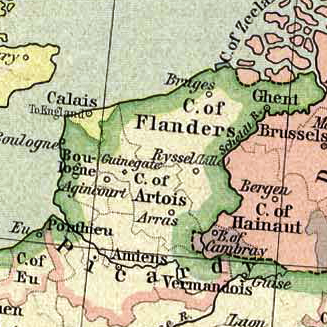Captain of Calais on:
[Wikipedia]
[Google]
[Amazon]
The town of
 The approaches to Calais, which is a port on the coast, were defended by two inland castles, that of
The approaches to Calais, which is a port on the coast, were defended by two inland castles, that of
Calais
Calais ( , , traditionally , ) is a port city in the Pas-de-Calais department, of which it is a subprefecture. Although Calais is by far the largest city in Pas-de-Calais, the department's prefecture is its third-largest city of Arras. Th ...
, now part of France, was in English hands from 1347 to 1558, and this page lists the commanders of Calais, holding office from the English Crown, called at different times Captain of Calais, King's Lieutenant of Calais (Castle), or Lord Deputy of Calais.
Terminology and background
Commands were over the castle of Calais, the town, the march and its outlying castles; command was often divided, and deputies frequently appointed for commanders who might be absent. The terminology was flexible, changed over time, and may not be accurately given in some sources. The military, political and even financial situation, and the presence or absence of officers, did affect how the system operated. The terms used changed over nearly two centuries. The system of royal officials set up after Edward III took Calais consisted of captain, marshal, seneschal and constable. But changes were soon seen. Calais refers properly here to thePale of Calais
The Pale of Calais was a territory in Northern France ruled by the monarchs of England for more than two hundred years from 1347 to 1558. The area, which was taken following the Battle of CrĂ©cy in 1346 and the subsequent Siege of Calais (1346â ...
, or March of Calais, part of the Kingdom of England
The Kingdom of England (, ) was a sovereign state on the island of Great Britain from 12 July 927, when it emerged from various Anglo-Saxon kingdoms, until 1 May 1707, when it united with Scotland to form the Kingdom of Great Britain.
On 1 ...
, namely the English bridgehead area between the County of Artois
The County of Artois (, ) was a historic province of the Kingdom of France, held by the Dukes of Burgundy from 1384 until 1477/82, and a state of the Holy Roman Empire from 1493 until 1659.
Present Artois lies in northern France, on the border ...
and County of Flanders
The County of Flanders was a historic territory in the Low Countries.
From 862 onwards, the counts of Flanders were among the original twelve peers of the Kingdom of France. For centuries, their estates around the cities of Ghent, Bruges and Ypr ...
; it varied in area according to the military position. The boundary took in wetlands and was not always clear, but the area amounted to about 20 square miles.
 The approaches to Calais, which is a port on the coast, were defended by two inland castles, that of
The approaches to Calais, which is a port on the coast, were defended by two inland castles, that of Guînes
Guînes (; vls, Giezene, lang; pcd, Guinne) is a commune in the northern French department of Pas-de-Calais. Historically it was spelt ''Guisnes''.
On 7 January 1785, Jean-Pierre Blanchard, a French pioneer in hydrogen-balloon flight, complete ...
, somewhat to the south-east, and Hammes (Hampnes, Hammez) in the present commune of Hames-Boucres
Hames-Boucres () is a commune in the Pas-de-Calais department in the Hauts-de-France region of France.
Geography
A village located 6 miles (9 km) southwest of Calais, at the junction of the D215 and D231E2.
History
The commune was creat ...
, somewhat to the southwest. Calais had also castellan
A castellan is the title used in Medieval Europe for an appointed official, a governor of a castle and its surrounding territory referred to as the castellany. The title of ''governor'' is retained in the English prison system, as a remnant o ...
s (of Calais Castle); "Captain of Calais Castle" is a different post from "Captain of Calais", the title of the top commander and military governor of the Pale for most of the period.
Deputies
When "deputy" is used, it may or may not mean a second-in-command: there is no consistency across the period. From Latin records there come "vice" (in the place of) or "locum tenens" (holding the place of). "Lieutenant" is a direct French translation of "locum tenens"; it means generally the second-in-command to the "captain" or head commander. There is a mention of a "deputy lieutenant", however. Caveats are required because a "lord deputy" has to be understood as deputy to the king; and the term "deputy governor" should usually be read "lord deputy and governor", not "deputy to the governor". The ''Lord Deputy of Calais'', a Tudor title only, was the English king's representative and head of the Council of Calais. The title of Lord Deputy was used in Calais only from 1507.http://www.oxforddnb.com/view/theme/93335?&back=13921 (ODNB subscription site). The Council existed in some form under Edward IV, and lasted until the French conquest of Calais in 1558. There could be more than one Deputy holding the title at a given time. In practical terms the Lord Deputy was also the military governor of Calais, but the two posts were not formally the same: in 1552 Lord William Howard became "lord deputy and governor of Calais". "Governor of Calais" may also refer to the French post after 1558.Captains and lieutenants of Calais
Lords deputies of Calais
See also
*Treasurer of Calais
The town of Calais, France, was in English hands from 1347 to 1558. During this historical period the task of the treasurer, in conjunction with the Captain of Calais, was keeping the defences in order, supplying victuals and paying the garrison ...
References
*R. A. Griffiths, ''The Reign of Henry VI'' (1998) *Notes
{{reflist History of Calais